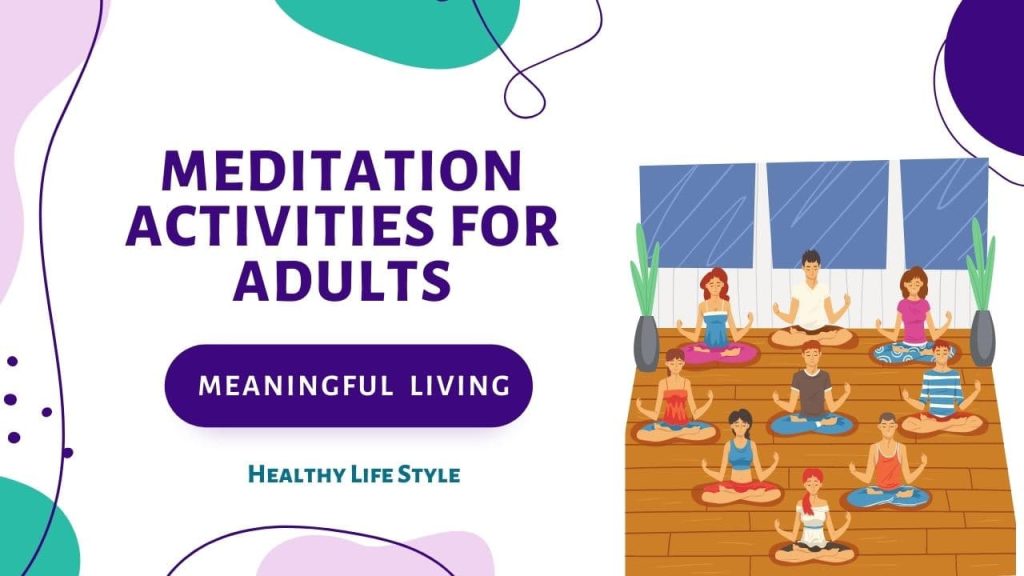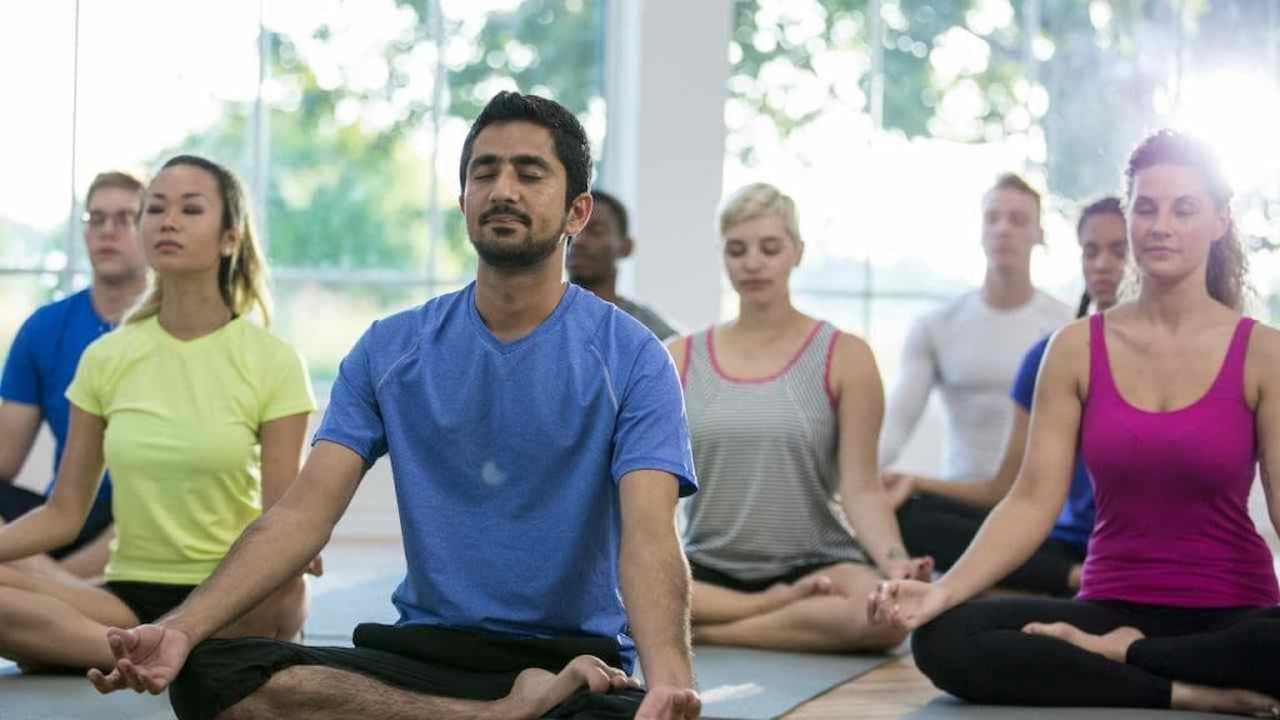For many, daily life has become much busier and filled with stress. Unfortunately, this has led to several adverse outcomes for people who are not equipped to handle it.
Stress has been identified as one of the leading causes of several very serious medical conditions in physical and mental health. This has led medical care providers to recommend several ways to combat stress.
One of the leading recommendations from medical doctors and other professionals is the use of mindful meditation activities. For many years meditation has brought relief for many who seek relief in their lives from the negative effects of stress. Mindfulness meditation is a difficult thing to put a definitive definition to, but it is the act of focusing one’s total attention on one specific thing.
Meditation is a practice that has grown in popularity. It can be done by anyone, at any time, and in any place. It can help with focus, creativity, and mood.
In this article, we will explore some fun group exercises and individual easu mindfulness exercises that can be used to help you achieve the goals of meditation. We hope that you find any of these mindfulness activities useful for you or your family member.
Group Meditation Activities for Adults

Here are 14 fun mindfulness meditation activities that can be done in a group setting:
Balloon Play
Balloon play is a unique game that is especially fun in a large group. The game is similar to a hacky sack in that you cannot let the balloon(s) touch the ground. There is no winner or loser, you have fun keeping the balloon in the air. You can start with a single balloon and add additional ones to make it more challenging.
Coloring Book Party
A coloring book party can be a very relaxing activity. While it may seem unusual activity for adults to be coloring pictures with crayons or markers, it is a really good way to get your mind off things and focus on the task at hand. The more complex the pictures that you choose, the more relaxing the activity will be.
Expressive Writing Exercise
This type of exercise requires a guide to help the group to get started and ensure that everyone is focusing on the emotions that they are feeling when they are stressed or anxious. The key to this activity is self-awareness and not having to worry about what others think about what you are writing.
Expressive writing allows you to channel your stress through continuous writing. Members of the group can later challenge their anxious thoughts by first learning to live in the moment and then taking note of the present. The group leader should talk about being present while also helping members learn about themselves. This is the process of self-awareness, which works well with more than one participant.
Here’s how to achieve that sensation:
STEP ONE: Congregate the group in one location. The group leader should calm the room, play soothing, meditative music, and then ask each person, one at a time, to describe one thing they like to do when they are stressed, upset, anxious, or annoyed. The group leader should ask them to talk about what’s bothering them right now, giving each member the opportunity to express themselves without judgment.
Step TWO: Unwind before you begin writing. Hands should be free, eyes should be closed, and ears should be focused on the music. Members should stand still for five minutes after engaging in physical activity. Each group member will inhale deeply, hold their breath, and exhale slowly, as with guided meditation. They will release tension and stress, improve concentration, and relax as a result.
Step THREE: Members of the group should begin writing freely. The group leader should prompt members’ memories as they write, focusing on questions that remind each member of the present calm. The relaxation after a long day, the changes in their breathing as they record one detail after another. Exercise is effective, healthy, and essential for reducing worries and stressors.
Group Booking Reading for Mindful Meditation
Unlike your traditional book clubs choose books for the group to read and then discuss the book. Reading for mindfulness in a group has everyone in the group reading a different passage out loud to the group.
This helps to get everyone involved and provides a much deeper understanding of what is being said in the book.
It also helps everyone in the group to focus more on what is being said in the book and less focused on the worries that they brought with them.ht be similar to Yoga in that you use certain poses and work on your breathing, but it’s not a type of Yoga. In fact, the two practices are very different.
Group Dancing
Mindful dancing is a very simple way to let go of the stress and simply feel the joy of the music. During the dance sessions there are no required movements, just go with the flow of the music. At the end of the dance session, you will feel a lot more relaxed and free from the stress of your day.

Looking Out the Window Together
Visualization exercises are a very effective way to relax and help to focus. Looking out a window as a group and sharing your thoughts about what you saw out the window can be very relaxing. You may want to select a visually pleasing location for your group session, this could be a park or nature preserve.
Mindful Listening Activities
Mindful listening in a group setting can be a great way to get you out of the daily work routine. You can either break up into pairs or stick with the whole group. Just take turns talking about anything and be sure to give the person speaking your undivided attention. This will help you to focus on the stress that you are feeling from your busy day.
Music Appreciation Exercise
Music has the power to melt away the worries of the day and take you to a peaceful place. As a group decides on what kind of music that you all want to listen to. Be sure to choose something that can motivate everyone to achieve the feeling of inner joy and peace. To get a much deeper appreciation for the beat of the music you should always remember to shut your eyes.
Shared
Mindful Self-compassion Session
When most people think of compassion it usually is referring to showing it toward another person. However, you cannot forget about yourself when it comes to expressing compassion. As a group you can, as a group share compassion for yourself and at the same time express compassion for one another.
The steps are as follows:
Step ONE: Make sure that everyone brings a notebook or something to write with. Once everyone is seated in a comfortable position, you can all begin writing down something painful.
There is no limit to what can be the subject of self-compassion; it could be a parking ticket or a life-changing event.
Step TWO: After everyone has written down one painful memory, the group can take turns reading what they have written and discussing why it is important for them to feel compassion for themselves.
After a person has finished speaking, the group can express feelings of compassion for the person, giving them the impression that their self-compassion is being reinforced externally.
If the people in your group are already friends, a person’s time can be completed with a hug from the next person who will share. This is entirely optional, but a hug from a friend can go a long way toward demonstrating how much better we feel when we share what is painful to us.
Step THREE: The group will continue to share the painful things that were written down until everyone has taken part.
It is critical to understand that a person may write down something painful but be unable to share it. Don’t press them; instead, give them time to write something else down or simply sit with the group.
Group Mindful Gardening Activities
Group mindful gardening activities work best with a guide. The focus of mindful gardening activities should be on a tranquil planting session rather than anything physically demanding.
Participants can expect to increase their focus and well-being as leaders provide encouragement and advice to help them become more aware of their immediate surroundings. Positive words and a comfortable environment, combined with the instruction of a leader, will succeed in soothing the thoughts of group members while they finish the activity.
The focus of mindful gardening activities should be on a tranquil planting session rather than anything physically demanding. Participants can expect to increase their focus and well-being as leaders provide encouragement and advice to help them become more aware of their immediate surroundings.
Positive words and a comfortable environment, combined with the instruction of a leader, will succeed in soothing the thoughts of group members while they finish the activity.
Prior to starting work, group members should understand the emotional benefits of gardening. Members gather equipment as a group when picking out vegetables and flowers. The sense of togetherness that comes with group shopping will give the group gardening exercise more meaning.
Focusing on the steady rhythm of the task is the best approach to making gardening work for mindfulness. Aside from the group leader’s encouragement, gardening should be mainly silent. Members will feel rejuvenated and less stressed in the end, and they will be conscious that they are feeling well, and pleased of their accomplishments.
Morning Coffee for Mindfulness
If there’s one good thing about a cup of coffee, it’s the burst of alertness that follows each drink. The sensation of squeezing this hot beverage down your throat makes you feel content, which can lead to peaceful discourse.
Why not take the group out for morning coffee?
Instead of sitting in silence, engage the group in some thankfulness exercises. But make sure that everyone expresses gratitude for anything in their immediate surroundings.
A group member might appreciate the vibrant colors of another group member’s outfit. Alternatively, the aromas of cocoa and cinnamon may appeal to them.
Group members ground themselves in the present by learning to connect with their surroundings, eliminating all that doesn’t matter at the time.
Mindful Snacking
Most people enjoy a snack, but we don’t always pay attention to what we eat. Becoming aware of the flavors, textures, and internal feelings of mindful snacking may surprise you with how much you miss on a daily basis.
We eat a lot, so this exercise may be really effective and beneficial.
It’s simple to include mindfulness snacking into your group meditation activities. The fundamentals are as follows::
1. A few foods that are a little different; an exotic cheese plate is a winner, but oatmeal medley is probably not the best subject.
2. A group of people who are not hungry (the urge to stamp out hunger will overcome the mindfulness in most people, at least until they are full).
3. Notepaper for recording your group members’ reactions to the food.
Body Scan Meditation
This great mindfulness activity will require a guide, who will be responsible for assisting the group in gradually scanning each area of their bodies with their awareness. It’s best to do this activity in a relaxed setting where the group members can lay down comfortably.
Every group member will find a comfortable position, such as lying on the floor or sitting in a chair, to begin the body scan. The position isn’t critical, but it should be comfortable to hold for more than 20 minutes.
Step ONE: Once everyone is settled, the guide will begin to help the group focus on a specific body part of their bodies. Deep breathing is often used to establish initial focus. It is best to remain still and relaxed during this exercise.
Step TWO: After focusing on the breath, the guide should instruct the group to become aware of how their body feels. Take note of any aches and pains, as well as how their clothing feels. After holding this awareness for a minute or two, the body scan can begin.
Step THREE: The guide will instruct the group to concentrate on a specific part of their bodies.
Many people start with their toes or feet The awareness is held in one place for a minute or two before shifting on. Before proceeding, the guide should instruct the group to wait for the next area.
Step FOUR: After giving mindful attention to the entire body, you will return your attention to the breath again for a few minutes. The guide can remind the group to keep track of any unusual feelings that arise during each mindful moments..
Individual Meditation Activities for Adults
If the thought of engaging in group mindfulness exercises makes you anxious or stressed, plunging into mindfulness practice alone may be the best way to start. Here are 7 EASY activities that might help you develop mindfulness in a different ways.
Three-Minute Breathing Space Exercises
One of the most simple mindfulness exercises is focusing on the breath. It is best performed sitting, with eyes closed and hands on knees or thighs. The nose is utilized to focus on the breath, and deep breaths are taken via the nose to fill the lungs before expelling through the mouth.
The 3-Minute Breathing Space exercise is ideal for individuals with busy lives and minds. The mindful breathing is divided into three parts, one each minute, and operates as follows:
The first minute is spent answering the question “how am I doing right now?” while focusing on the feelings, thoughts, and sensations that occur and attempting to give them words and phrases.
The second minute is dedicated to maintaining awareness of the breath.
The last minute is intended to expand your focus away from the breath, noticing how your breathing impacts the rest of your body.
Five Senses Exercises
This great activity is known as “five senses,” which enables you to practice sensory experience in almost any setting. All that is required is to observe something with each of your five senses.
This is an easy and simple exercise that will rapidly get you to a level of mindfulness.
If you don’t have the time or resources to perform a body scan, the five senses exercise can assist you bring consciousness to the present moment in a short amount of time.
To practice the Five Senses, go in the following order:
1. Take note of the five items you can see.
· Look around you and focus your attention on five items you notice. Choose something you wouldn’t ordinarily notice, such as a shadow or a little fracture in the pavement.
2. Take note of four things you can feel.·
Bring your attention to four sensations that you are presently experiencing, such as the texture of your jeans, the feel of the air on your skin, or the smooth surface of a table on which you are resting your hands.
3. Take note of three things you can hear.
· Take a time to listen and make a mental note of three things you hear in the background. This might be a bird’s chirp, the hum of a refrigerator, or the faint noises of traffic on a nearby road.
4. Take note of two items you can smell.
· Bring your attention to odors that you normally ignore, whether they are pleasant or unpleasant. If you’re outside, the air may be delivering a whiff of pine trees or the aroma of a fast-food restaurant across the street.
5. Take note of one thing you can taste.
· Concentrate on one item that you can taste right now. You can sip a drink, chew gum, eat something, observe the present flavor in your tongue, or even open your lips to hunt for a taste in the air.
The Observer Meditation
This activity will assist you in practicing being an observer of yourself since we are frequently prone to react to and over-identify with our feelings.
Adopting an Observer viewpoint can assist us in establishing some space between who we are and problematic areas in life with which we may be overidentifying.
The purpose of invoking the Observing Self is to enter a distinct state that allows you to distance yourself from yourself and your experiences. However, you are also connecting with a deeper continuous self that is untouched by dynamic emotions.
To begin the mindful observation exercise, do the following:
· Take a comfy place and allow yourself to settle into your body and thoughts, take a slow deep breath..
· Try to let ideas go and cleanse your mind of its regular concerns.
· Pay close attention to the room you’re sitting in initially. As you sit, see yourself from the outside, as an outsider might.
· Next, concentrate your attention on your skin. Try to feel your skin while sitting on the chair.
· Envision the shape that your skin forms as you sit in touch with the chair.
· Moving your awareness to any physical sensation you are experiencing. As you sense each one, recognize its presence before letting go of your consciousness, and move on to the next physical sensation naturally.
· When any positive emotions arise, acknowledge them and make room for them. Then return your focus to your observing self—your feelings and thoughts are still there, but you are apart from them, noticing them. This is the “Observer you.”
Mindful Stretching Exercises
The majority of people lead a sedentary lifestyle that includes long periods of sitting. Whether it’s cramped office cubicles or long hours working from home, most employees in the modern era aren’t getting enough exercise in their life.
Stretching, luckily, improves motion and flexibility. Stretching your muscles helps to make feel better. Making stretching part of your mindful meditation will put you all in the right frame of mind and help to relax you. Stretching can also help to take everyone’s minds off any worries from the day’s work.
The mind and body interact during stretching. During and after stretching, you will feel more relaxed, cheerful, comfortable, and present. your should attempt to hold your stretches for 60 seconds, at least 15-30, and repeat no less than two.
Stretching increases mobility and protects you from injury. Make sure to include this activity in your mindfulness routine.
Mindful Immersion Exercises
The goal of this practice is to create satisfaction in the present moment and escape the everyday struggle.
Rather than rushing through a daily routine activity in order to go on to something else, immerse yourself in it as never before. For example, if you are cleaning your house, pay attention to every element of the operation.
Rather of seeing this as a routine duty, make it an altogether new experience by paying attention to every detail of your actions. Feel and become the action of sweeping the floor, experience the muscles used when washing the dishes, and devise a more effective method of cleaning the windows.
The goal is to be inventive and explore fresh experiences inside a typical work.
Instead of slaving away and always worrying about how to complete the work, become aware of each stage and totally immerse yourself in the process. Extend the exercise beyond a habit by committing to it physically, psychologically, and spiritually.
Mindful Appreciation Exercises
In this exercise, all you have to do is notice 5 things, people or objects, in your day that go unnoticed. Check off 5 items on a notepad by the end of the day.
The purpose of this exercise is to simply give thanks and appreciate the seemingly insignificant things in life, the things that sustain our existence but are rarely given a second thought in our desire for bigger and better things.
Once you’ve identified your five things, make it your mission to learn everything you can about their creation and purpose so you can truly appreciate how they help you in your life.
For example, electricity powers your kettle, the postman delivers your mail, your clothes keep you warm, your nose allows you to smell the flowers in the park, and your ears allow you to hear the birds in the tree next to the bus stop, but…
- Do you know how these things/processes came to be or how they function?
- Have you ever considered how these things improve your life and the lives of others?
- Have you ever considered what life would be like without these things?
- Have you ever paid attention to their finer, more intricate details?
- Have you ever sat down and considered the relationships between these things and how they all work together to keep the earth running?
Mindful Walking Exercises
Mindful walking is a style of meditation that may be done while walking rather than sitting. This sort of meditation assists people in remaining concentrated as they walk with their eyes open or closed and their hands clasped behind their back or by their sides.
Walking meditation has several advantages. It helps individuals focus, decreases tension and anxiety, and enhances their mood, among other things.
Walking meditation is an excellent practice of mindfulness for people to meditate if they do not have the time or chance to meditate for extended periods of time due to their busy lifestyles.
Conclusion
Mindfulness meditation for adults is an easy and good option to relax and forget about all of the struggles, stress, and worries of the day.
When putting meditation activities into a group setting, then you have a room full of people to reduce their stress levels at the same time as you. Just remember there is power in numbers and with more people having the same goal you will be able to achieve the preferred outcome a lot faster than you would by yourself.
We have explored both group and individual meditation activities, exercises, and techniques in this article. Consider participating in one of the activities listed above if you haven’t already. The activities help us become more aware of our body, thoughts, and selves throughout time.
A wide range of people can benefit from mindfulness. It is a simple technique that has tremendous effects on the brain and can improve people’s quality of life, self-confidence, and peace of mind.
Please share your mindfulness meditation experiences, as well as any tools or exercises you use to promote awareness in your life, in the comments section below.
We hope you found this post useful and interesting!
Resources:










